

Now that you have spent some time exploring your values and your goals, you can easily see how you need to manage your time well in order to accomplish your goals. When you have a long-term goal and break it down into mid-term and short-term goals, it leads to the question, “What do I need to do today in order to achieve my goal?” This question is at the heart of time management. Your goals guide how you spend your time and resources. Having clearly defined goals with specific deadlines leads you to be deliberate in planning your time and makes it easier to establish an effective time management system.
As most students discover, college is not the same as high school. For many students, college is the first time they are “on their own” in an environment filled with opportunity. And while this can be exciting, you may find that social opportunities and job responsibilities conflict with academic expectations. For example, a free day before an exam, if not wisely spent, can spell trouble for doing well on the exam. It is easy to fall behind when there are so many choices and freedoms.
One of the main goals of a college education is learning how to learn. In this section, we zoom in on learning how to skillfully manage your time. To be successful in college, it’s imperative to be able to effectively manage your time and to manage all aspects of your life including school, work, and social opportunities. Time management isn’t actually difficult, but you do need to learn how to do it well.
Thinking about your goals gets you started, but it’s also important to think about priorities. We often use the word “priorities” to refer to how important something is to us. We might think, This is a really important goal, and that is less important. Try this experiment: go back to the goals you wrote in the last chapter and see if you can rank each goal as a 1 (top priority), 2 (middle priority), or 3 (lowest priority).
It sounds easy, but do you actually feel comfortable doing that? Maybe you gave a priority 1 to passing your courses and a priority 3 to playing your guitar. So what does that mean—that you never play guitar again, or at least not while in college? Whenever you have an hour free between class and work, you have to study because that’s the higher priority? What about all your other goals—do you have to ignore everything that’s not a priority 1? And what happens when you have to choose between different goals that are both number 1 priorities?
In reality, priorities don’t work quite that way. It doesn’t make a lot of sense to try to rank goals as always more or less important. The question of priority is really a question of what is more important at a specific time. It is important to do well in your classes, but it’s also important to earn money to support yourself and have a social life. You shouldn’t have to choose between these, except at any given time. Priorities always involve time: what is most important to do right now. Time management is mostly a way to juggle priorities so you can meet all your goals.
When you manage your time well, you don’t have to ignore some goals completely in order to meet other goals. In other words, you don’t have to give up your life when you register for college, but you may need to work on managing your life and time more effectively.
But, time management works only when you’re committed to your goals. Attitude and motivation are very important. If you haven’t yet developed an attitude for success, all the time management skills in the world won’t keep you focused and motivated to succeed.
One way to help you identify your priorities is with the “Eisenhower Box,” a tool to help evaluate urgency and importance. Items may be placed at more precise points within each quadrant.
The “Eisenhower Method” stems from a quote attributed to Dwight D. Eisenhower: “I have two kinds of problems, the urgent and the important. The urgent are not important, and the important are never urgent.”
Using the Eisenhower Decision Principle, tasks are evaluated using the criteria important/unimportant and urgent/not urgent, and then placed in according quadrants in an Eisenhower Matrix (also known as an “Eisenhower Box” or “Eisenhower Decision Matrix”). It is important to understand the difference between urgency and importance. An urgent item needs to be dealt with immediately. An item that is important needs to be dealt with but may or may not needs to be dealt with immediately. Tasks are then handled as follows:
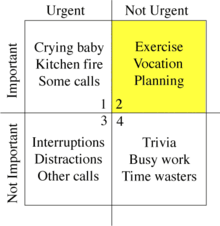
As you can see, the Urgent/Important category (#1) needs to be attended to first and should top your list of priorities, followed by the Not Urgent/Important category (#2). You can imagine that the Category #1 is a stressful place, with emergencies and crises, and one you would like to avoid. Life will bring you plenty of Category #1 items so try your best to keep things out of that category. Work productively in Category #2 so items don’t unnecessarily end up being urgent. For example, a paper or a test shouldn’t be urgent, as they aren’t last minute crisis. The more you focus on Category #2, the more you accomplish with less stress.
People’s attitudes toward time vary widely. One person seems to be always rushing around but actually gets less done than another person who seems unconcerned about time and calmly goes about the day. Since there are so many different “time personalities,” it’s important to realize how you approach time. Try the following activity to help you identify your personal time management style.
The following self-assessment survey can help you determine your time-management personality type. Read each question in the Questions column. Then read the possible responses. Select one response for each question. Each response should reflect what you probably would do in a given situation, not what you think is the “right” answer. Put a checkmark in the My Time Management Type column next to your likely response.
| QUESTIONS | RESPONSES: Which response most closely matches what you would do? In the right column, check one response (a, b, c or d) for each question. | MY TIME MANAGEMENT TYPE | |
|---|---|---|---|
| 1 | Your instructor just gave your class the prompts for your first essay, which is due in two weeks. How do you proceed from here? | a) Choose a prompt and begin working on a thesis immediately. Better to get it out of the way! | Early bird |
| b) Read over the prompts and let them sink in for a week or so. You’ll still have one more week to finish the assignment, right? | Balancing act | ||
| c) Read the prompts and maybe start playing around with ideas, but wait to really start writing until the day before. You swear it’s all in your head somewhere! | Pressure cooker | ||
| d) Look at the prompts the morning that assignment is due and quickly type up your essay. This makes you late for class, but at least you got it turned in on time. | Inproviser | ||
| 2 | You are working on a group assignment that requires you to split up responsibilities with three other classmates. When would you typically finish your part? | a) First. Then you’re done and don’t have to worry about it. Plus it could give you time in case you want to tweak anything later. | Early bird |
| b) After one or two of the others have submitted their materials to the group, but definitely not last. You wanted to see how they approached it first. | Balancing act | ||
| c) Maybe last, but definitely before the assignment due date and hopefully before any of the other group members ask about it. | Pressure cooker | ||
| d) Definitely last. You’ll wait until everyone else has done their work, so you can make sure you are not duplicating efforts. Whatever, this is why you hate group work. | Inproviser | ||
| 3 | Your instructor just shared the instructions for your next assignment and you read them but don’t quite understand what he’s asking for in a certain part. What would you probably do? | a) Send the instructor an email that afternoon. When he doesn’t respond that night, email him again. This is your worst nightmare—you just want to know what he wants!! | Early bird |
| b) Send him an email asking for clarification, giving yourself enough time to wait for his response and then complete the assignment. Better to be safe than sorry. | Balancing act | ||
| c) Try to figure it out for yourself. You’re pretty sure what he’s trying to say, and you’ll give it your best shot. | Pressure cooker | ||
| d) Don’t say anything until after the assignment is due. Other people in the class felt the same way too, probably! | Inproviser | ||
| 4 | The course you are taking requires you to post in a weekly discussion forum by Sunday night each week so the class can talk about everyone’s posts on Monday. When do you submit your posts? | a) Tuesday night, after the first day of class that week. Then it’s out of the way. | Early bird |
| b) Thursday or Friday night. You want to let the week’s discussion sink in a little so you can collect your thoughts. | Balancing act | ||
| c) Sunday night. You always forget over the weekend! | Pressure cooker | ||
| d) Monday at 3 AM. That still counts as Sunday night, right? | Inproviser | ||
| 5 | You have an important assignment due Monday morning, and you have a social/work/family obligation that will keep you busy for most of the weekend. It is now the Wednesday before the assignment is due. How would you approach this dilemma? | a) You already finished it yesterday, the day it was assigned. Done! | Early bird |
| b) You tell yourself that you’ll finish it by Friday night, and you manage this by chipping away at it over those 3 days. …Little. By. Little. | Balancing act | ||
| c) You tell yourself that you’ll finish it by Friday night, so you can have your weekend free, but you still have a little left to do on Sunday—no big deal. | Pressure cooker | ||
| d) You tell yourself that you’ll take the weekend off, then stay up late on Sunday or wake up early on Monday to finish it. It’s not a final or anything, and you have a life. | Inproviser | ||
| 6 | You have to read 150 pages before your next class meeting. You have 4 days to do so. What would you most likely do? | a) 150 pages divided by 4 days means… a little less than 40 pages a day. You like to chunk it this way because then you’ll also have time to go over your notes and highlights and come up with questions for the instructor. | Early bird |
| b) 150 pages divided by…well … 2 days (because it’s been a long week), means 75 pages a day. Totally doable. | Balancing act | ||
| c) 150 pages, the day before it is due. You did this to yourself, it’s fine. | Pressure cooker | ||
| d) How much time does it take to skim the text for keywords and/or find a summary online? | Inproviser |
Which of the four basic time-management personality types did you select the most? Which did you select the least? Do you feel like these selections match the student you have been in the past? Has your previous way of doing things worked for you, or do you think it’s time for a change? Remember, we can all always improve!
Learn more below about your tendencies. Review traits, strengths, challenges, and tips for success for each of the four time-management personality types.
People also differ in how they respond to schedule changes. Some go with the flow and accept changes easily, while others function well only when following a planned schedule and may become upset if that schedule changes. If you do not react well to an unexpected disruption in your schedule, plan extra time for catching up if something throws you off. This is all part of understanding your time personality.
Another aspect of your time personality involves the time of day. If you need to concentrate, such as when writing a class paper, are you more alert and focused in the morning, afternoon, or evening? Do you concentrate best when you look forward to a relaxing activity later on, or do you study better when you’ve finished all other activities? Do you function well if you get up early, or stay up late, to accomplish a task? How does that affect the rest of your day or the next day? Understanding this will help you better plan your study periods.
While you may not be able to change your “time personality,” you can learn to manage your time more successfully. The key is to be realistic. The best way to improve your time management is to take an honest look at how you are currently spending your time.
The best way to know how you spend your time is to record what you do all day in a time log, every day for a week, and then add that up. First, you want to take your best guess at how you are currently spending your time so you can compare that with how you are actually spending your time. This helps you identify the areas you need to work on.
See if you can account for a week’s worth of time. For each of the activity categories listed, make your best estimate of how many hours you spend in a week. (For categories that are about the same every day, just estimate for one day and multiply by seven for that line.)
| Category of Activity | Estimated Hours per Week | |
|---|---|---|
| Sleeping | ||
| Eating (including preparing food) | ||
| Personal hygiene (i.e., bathing, etc.) | ||
| Working (employment) | ||
| Volunteer service or internship | ||
| Chores, cleaning, errands, shopping, etc. | ||
| Attending class | ||
| Studying, homework, reading, and researching (outside of class) | ||
| Transportation to work or school | ||
| Getting to classes (walking, biking, etc.) | ||
| Organized group activities (clubs, church services, etc.) | ||
| Time with friends (include television, video games, etc.) | ||
| Attending events (movies, parties, etc.) | ||
| Time alone (include television, video games, surfing the Web, etc.) | ||
| Exercise or sports activities | ||
| Reading for fun or other interests done alone | ||
| Time on the phone, texting, Facebook, Twitter, etc. | ||
| Other—specify: ________________________ | ||
| Other—specify: ________________________ | ||
| TOTAL (168 hours in a week) |
Now use your calculator to total your estimated hours. Is your number larger or smaller than 168, the total number of hours in a week? If your estimate is higher, go back through your list and adjust numbers to be more realistic. But if your estimated hours total fewer than 168, don’t just go back and add more time in certain categories. Instead, ponder this question: Where does the time go? We’ll come back to this question.
Next, print the Time Log and carry it with you throughout the week. Every few hours, fill in what you have been doing. Do this for a week before adding up the times; then enter the total hours in the categories in Activity 2. You might be surprised that you spend a lot more time than you thought just hanging out with friends, or surfing the Web or playing around with Facebook or any of the many other things people do. You might find that you study well early in the morning even though you thought you are a night person, or vice versa. You might learn how long you can continue at a specific task before needing a break.
| Sunday | Monday | Tuesday | Wednesday | Thursday | Friday | Saturday | |
|---|---|---|---|---|---|---|---|
| 6-7am | |||||||
| 7-8am | |||||||
| 8-9am | |||||||
| 9-10am | |||||||
| 10-11am | |||||||
| 11-12pm | |||||||
| 12-1pm | |||||||
| 1-2pm | |||||||
| 2-3pm | |||||||
| 3-4pm | |||||||
| 4-5pm | |||||||
| 5-6pm | |||||||
| 6-7pm | |||||||
| 7-8pm | |||||||
| 8-9pm | |||||||
| 9-10pm | |||||||
| 10-11pm | |||||||
| 11-12am | |||||||
| 12-1am | |||||||
| 1-2am | |||||||
| 2-3am | |||||||
| 3-4am | |||||||
| 4-5am | |||||||
| 5-6am |
Now that you’ve evaluated how you have done things in the past, you’ll want to think about how you might create a schedule for managing your time well going forward. The best schedules have some flexibility built into them, as unexpected situations and circumstances will likely arise during your time as a student.
For every hour in the classroom, college students should spend, on average, about two to three hours on that class reading, studying, writing papers, and so on. Look at the following scenarios to get an idea of how many hours you should be spending on your classes outside of class time.
12 credit hours over a 15-week session = 12 hours a week in class + 24-36 hours outside of class
6 credit hours over a 15-week session = 6 hours a week in class + 12-18 hours outside of class
3 credit hours over a 6-week session = 8 hours a week in class + 16-24 hours outside of class
If you’re a full-time student with twelve hours a week in class plus your study time, that 36-42 hours is about the same as a typical full-time job, which is why you are considered to be a full-time student. If you work part-time or have a family, time management skills are even more essential. To succeed in college, everyone has to develop effective strategies for dealing with time.
Look back at the number of hours you wrote in Activity 2 for a week of studying. Do you have two to three hours of study time for every hour in class? Many students begin college not knowing this much time is needed, so don’t be surprised if you underestimated this number of hours. Remember this is just an average amount of study time—you may need more or less for your own courses. To be safe, and to help ensure your success, add another five to ten hours a week for studying.
To reserve this study time, you may need to adjust how much time you spend on other activities. Activity 3 will help you figure out what your typical week should look like.
Plan for the ideal use of a week’s worth of time. Fill in your hours in this order:
| Category of Activity | Hours Per Week |
|---|---|
| Attending class | |
| Studying, reading, and researching (outside of class) | |
| Working (employment) | |
| Transportation to work or school | |
| Sleeping | |
| Eating (including preparing food) | |
| Personal hygiene (i.e., bathing, etc.) | |
| Chores, cleaning, errands, shopping, etc. | |
| Volunteer service or internship | |
| Getting to classes (walking, biking, etc.) | |
| Subtotal: | |
| Discretionary activities: | |
| Organized group activities (clubs, church services, etc.) | |
| Time with friends (include television, video games, etc.) | |
| Attending events (movies, parties, etc.) | |
| Time alone (include television, video games, surfing the Web, etc.) | |
| Exercise or sports activities | |
| Hobbies or other interests done alone | |
| Time on the phone, texting, Facebook, Twitter, etc. | |
| Other—specify: ________________________ | |
| Other—specify: ________________________ |
Activity 3 shows most college students that they do actually have plenty of time for their studies without losing sleep or giving up their social life. But you may have less time for discretionary activities, like video games or watching movies, than in the past. Something, somewhere has to give. That’s part of time management and why it’s important to keep your goals and priorities in mind.
Below is an example of a student’s weekly schedule, with designated times for class, work and study time.
Kai’s Schedule
Since Kai’s Spanish class starts his schedule at 9:00 every day, Kai decides to use that as the base for his schedule. He doesn’t usually have trouble waking up in the mornings (except on the weekends), so he decides that he can do a bit of studying before class. His Spanish practice is often something he can do while eating or traveling, so this gives him a bit of leniency with his schedule.
| Sunday | Monday | Tuesday | Wednesday | Thursday | Friday | Saturday | |
|---|---|---|---|---|---|---|---|
| 7am | |||||||
| 8am | Spanish 101 | Spanish 101 | Spanish 101 | Spanish 101 | Spanish 101 | ||
| 9am | Spanish 101 | Spanish 101 | Spanish 101 | Spanish 101 | Spanish 101 | ||
| 10am | US History I | Spanish 101 | US History I | Spanish 101 | US History I | Work | |
| 11am | College Algebra | Intro to Psychology (ends at 12:30) | College Algebra | Intro to Psychology (ends at 12:30) | College Algebra | ||
| 12pm | Spanish 101 | Spanish 101 | Spanish 101 | ||||
| 1pm | Spanish 101 | Work (start 12:30 end 4:30) | Work (start 12:30 end 4:30) | Work (start 12:30 end 4:30) | Spanish 101 | ||
| 2pm | US History I | Work | Work | Intro to Psych | |||
| 3pm | |||||||
| 4pm | |||||||
| 5pm | College Algebra | College Algebra | College Algebra | ||||
| 6pm | |||||||
| 7pm | |||||||
| 8pm | Intro to Psych | Intro to Psych | |||||
| 9pm | US History I | US History I | |||||
| 10pm |
Now that you know what you need to be spending your time on, let’s work on getting it put into a schedule or calendar. The first thing you want to do is select what type of planner or calendar you want to use. There are several to choose from. The following chart outlines some pros and cons to different systems. online calendars, weekly calendars, monthly calendars and wall calendars.
| Type | Examples | Cost | Pros | Cons |
|---|---|---|---|---|
| Weekly Planner | 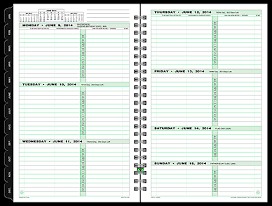 |
$5-$10 |
|
|
| Monthly Planner |  |
$5-$15 |
|
|
| Daily Planner | 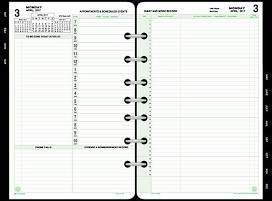 |
$5-$10 |
|
|
| Electronic Calendar | 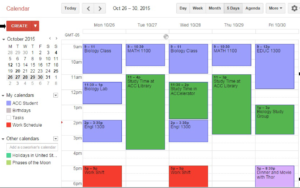 |
Free |
|
|
| Dry Erase Calendar |  |
$15-$20 |
|
|
Priorities
Discretionary Time
Reminders
Your schedule will vary depending on the course you’re taking. So pull out your syllabus for each class and try to determine the rhythm of the class by looking at the following factors:
Remember your goals. Does your schedule reflect your goals? Set your short and long-term goals accordingly. Ask yourself the following:
Don’t try to micromanage your schedule. Don’t try to estimate exactly how many minutes you’ll need two weeks from today to read a given chapter in a given textbook. Instead, just choose the blocks of time you will use for your studies. Don’t yet write in the exact study activity, just reserve the block. Next, look at the major deadlines for projects and exams that you wrote in earlier. Estimate how much time you may need for each and work backward on the schedule from the due date.
| Assignment | Due Date |
|---|---|
| Research Paper Due | May 1 |
| Final Draft | April 28 |
| Rough Draft | April 21 |
| Final Outline | April 7 |
| Find Sources | March 24 |
| Thesis Statement | March 17 |
| Select Topic | March 10 |
You have now created a series of assignments for yourself that will keep you on track for your project. Put these dates in your planner the same way you would any other assignment.
People use to-do lists in different ways, and you should find what works best for you. As with your planner, consistent use of your to-do list will make it an effective habit.
Some people prefer not to carry their planner everywhere but instead, copy the key information for the day onto a to-do list. Using this approach, your daily to-do list starts out with your key scheduled activities and then adds other things you hope to do today. This is a good fit for those that prefer to keep a wall calendar at home rather than carry their planner with them.
Some people use their to-do list only for things not included in their planners, such as short errands, phone calls or e-mail, and the like. This still includes important things, but they’re not scheduled out for specific times like your planner is.
Although we call it a daily list, the to-do list can also include things you may not get to today but don’t want to forget about. Keeping these things on the list, even if they’re a low priority, helps ensure that eventually, you’ll get to it.
Just as there are several options for planners, there are different types of to-do lists. Check your planner to see if it has one incorporated. If not, get a small notebook or pad of paper that you will designate as your to-do list. Of course, there’s always an app for that! Your smartphone likely came with a Reminder App or another type of To-Do List app. There are also many free apps to choose from and there are apps to help you manage your homework and assignments. Take a few minutes to look through your options to pick the best one for you.
Your To-Do list should be a reflection of your goals and priorities and should support your planner Your To-Do List should answer the question, “What do I have to do today, this week, this month?”
Here are some examples of different to-do lists.

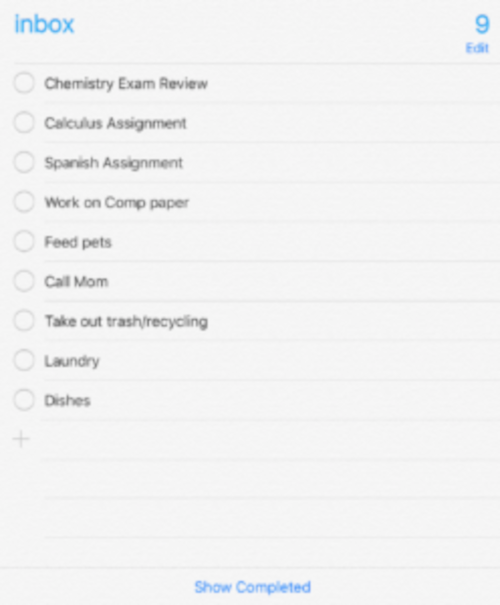

Use whatever format works best for you to prioritize or highlight the most important activities.
Here are some more tips for effectively using your daily to-do list:
Following are some strategies you can begin using immediately to make the most of your time:
If you’re both working and taking classes, you seldom have large blocks of free time. Avoid temptations to stay up very late studying, for losing sleep can lead to a downward spiral in performance at both work and school. Instead, try to follow these guidelines:
Living with family members often introduces additional time stresses. You may have family obligations that require careful time management. Use all the strategies described earlier, including family time in your daily plans the same as you would hours spent at work. Don’t assume that you’ll be “free” every hour you’re home, because family events or a family member’s need for your assistance may occur at unexpected times. Schedule your important academic work well ahead and in blocks of time you control. See also the earlier suggestions for controlling your space: you may need to use the library or another space to ensure you are not interrupted or distracted during important study times.
Students with their own families are likely to feel time pressures. After all, you can’t just tell your partner or kids that you’ll see them in a couple years when you’re not so busy with job and college! In addition to all the planning and study strategies discussed so far, you also need to manage your family relationships and time spent with family. While there’s no magical solution for making more hours in the day, even with this added time pressure there are ways to balance your life well:
Do any of the following descriptions apply to you?
If these sound like issues you’ve struggled with in the past, you might want to consider whether you have the tendency to procrastinate and how you want to deal with it in your future classes. You’re already spending a lot of time, energy, and money on the classes you’re taking—don’t let all of that go to waste!
Procrastination is a way of thinking that lets one put off doing something that should be done now. This can happen to anyone at any time. It’s like a voice inside your head keeps coming up with these brilliant ideas for things to do right now other than studying: “I really ought to get this room cleaned up before I study” or “I can study anytime, but tonight’s the only chance I have to do X.” That voice is also very good at rationalizing: “I really don’t need to read that chapter now; I’ll have plenty of time tomorrow at lunch...”
Procrastination is very powerful. Some people battle it daily, others only occasionally. Most college students procrastinate often, and about half say they need help to avoid procrastination. Procrastination can threaten one’s ability to do well on an assignment or test.
People procrastinate for different reasons. Some people are too relaxed in their priorities, seldom worry, and easily put off responsibilities. Others worry constantly, and that stress keeps them from focusing on the task at hand. Some procrastinate because they fear failure; others procrastinate because they fear success or are so perfectionistic that they don’t want to let themselves down. Some are dreamers. Many different factors are involved, and there are different styles of procrastinating.
Just as there are different causes, there are different possible solutions to procrastination. Different strategies work for different people. The time management strategies described earlier can help you avoid procrastination. Because this is a psychological issue, some additional psychological strategies can also help:
A well-known technique for managing time that can help with procrastination is called the Pomodoro Technique, developed by Francesco Cirillo in the 1980s and named after the popular tomato-shaped kitchen timer (pomodoro means “tomato” in Italian.) This simple technique is a method of managing procrastination by breaking down your work periods into small, manageable units. The system operates on the belief that by dividing your work and breaks into regular, short increments you can avoid feeling overwhelmed by a looming task while also avoiding burn out.
Here are the basics:
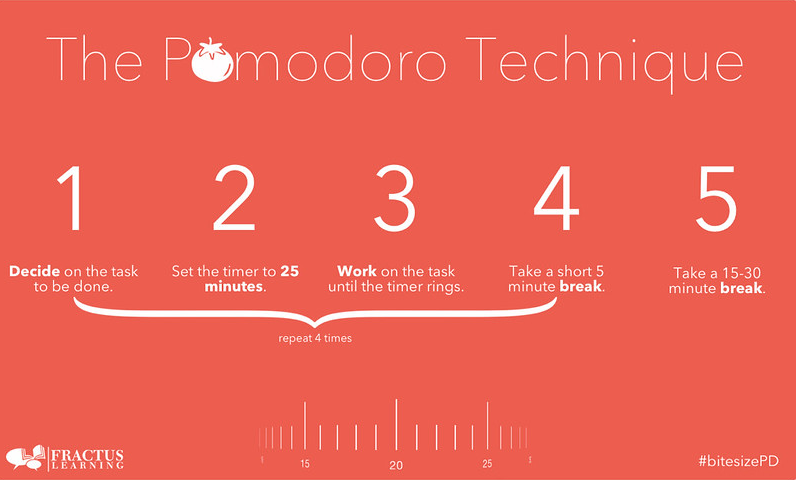
Give it a try if you’re interested in breaking your studying into manageable tomato-sized bites while developing a greater understanding of time management and how long it will take to complete a task.
Now that you have a better understanding of how you are spending your time, write a journal entry that identifies your time traps and what strategies you can implement to overcome those time traps.
What is a time trap? A time trap is something you end up spending a lot of time that doesn’t support your goals or priorities. They take up your time, energy and focus if you let them. The way to avoid time traps is to be aware of what your personal time traps are and have a plan for how you will avoid or reduce them. We all have our own personal time traps. What are yours? To help you get started, here’s a list of some common time traps:
Look at your Time Log from Activity #2. What were your two most common time traps? How did these time traps distract you from your priorities?
For each of your two time traps, come up with two specific plans to effectively avoid or reduce those time traps.
What time management strategies can you implement that can support your plans to avoid your time traps?
Authored by: Heather Syrett. Provided by: Austin Community College.
License: CC Attribution-NonCommercial-ShareAlike 4.0 International (CC BY-NC-SA 4.0)